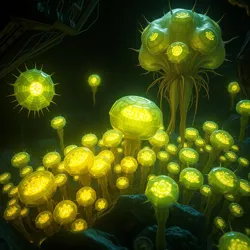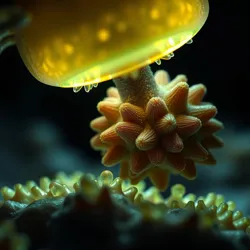Radiotrophs
Radiotrophs are a diverse group of organisms capable of deriving energy directly from various forms of radiation. First discovered in the Proxima Deep Caves in 2184, these remarkable life forms have revolutionized our understanding of potential energy sources for biological systems.
 A bioluminescent colony of radiotrophs thriving in the radiation fields of Nova Station
A bioluminescent colony of radiotrophs thriving in the radiation fields of Nova StationBiology and Mechanisms
Radiotrophs utilize specialized cellular structures called radiation capture centers (RCCs) to convert various forms of radiation into usable biological energy. These organelles contain unique molecules capable of absorbing and processing different wavelengths of radiation, from gamma rays to cosmic radiation.
Types of Radiotrophs
- Primary Radiotrophs - Organisms that obtain all their energy from radiation
- Facultative Radiotrophs - Species that can switch between radiotrophic and conventional energy metabolism
- Symbiotic Radiotrophs - Organisms that form energy-sharing partnerships with non-radiotrophic species
Habitat and Distribution
Most radiotrophs are found in environments with naturally high radiation levels, such as:
- Deep space environments
- The surfaces of worlds with thin atmospheres
- Areas near stellar phenomena
- Radiation zones created by ancient technological artifacts
 Microscopic image showing the crystalline structure of radiation capture centers
Microscopic image showing the crystalline structure of radiation capture centersScientific Applications
The study of radiotrophs has led to several breakthrough technologies:
Energy Generation
The Radiosynthetic Power Initiative has successfully developed artificial RCC arrays based on radiotrophic biology, creating new possibilities for sustainable energy production.
Space Exploration
Radiotrophic organisms have been incorporated into the design of self-sustaining space habitats, where they help shield other life forms from harmful radiation while generating useful energy.
Environmental Remediation
Some radiotroph species are being used to clean up radioactive contamination through a process known as bioradiation sequestration.
Ecological Impact
Radiotrophs play crucial roles in various extraterrestrial ecosystems, particularly in the Stellar Void Biomes where conventional photosynthesis is impossible. They often form the foundation of unique food webs that thrive in radiation-rich environments.
Research Challenges
Current challenges in radiotrophic research include:
- Understanding the limits of radiation tolerance
- Mapping the evolutionary pathways that led to radiotrophic adaptation
- Developing new methods for cultivating radiotrophs in laboratory conditions
See Also
- Radiation Capture Centers
- Stellar Void Biomes
- Bioradiation Sequestration
References
- Journal of Xenobiological Energy Systems
- Handbook of Radiotrophic Organisms
- Deep Space Ecology Quarterly